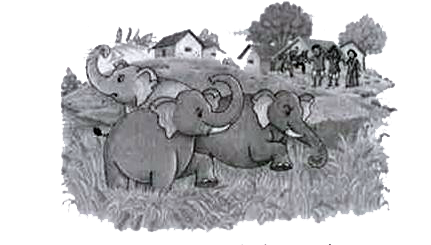Describe the impact of 'Rinderpest' on people's livelihoods and local economy in Africa in the 1890s.
Coming of rinderpest to Africa. Rinderpest, a cattle plague, was brought to Africa by the infected cattle imported from British Asia to feed the Italian soldiers invading Eritrea in East Africa, Entering in the East, rinderpest travelled towards the West like forest fire reaching up to Africa.s Atlantic coast and later the Cape.
Effect. The arrival of rinderpest devastated the cattle population. It killed 90 per cent of the cattle. The loss of cattle destroyed African livelihoods and most of the small holders of livestock were forced to join the labour market monopolised by planters, mine owners and colonial governments.
Topper's Solved these Questions
Similar Questions
Knowledge Check
Arrange the following in the correct sequence:
(i) Indentured Labour was abolished.
(ii) Rinderpest (Cattle Plague) had a terrifying impact on livelihoods of the African people and the local economy.
(iii) The First World War was fought.
(iv) Potato Famine in Ireland.
Options:A(iv) -(ii)-(iii)-(i)B(iii)-(i)-(iii)-(ii)C(i) -(iv)-(iii) -(ii)D(ii) -(iii)-(iv)-(i)Rinderpest arrived in Africa in the late 1880s. It was carried by infected cattle imported from British Asia to feed the Italian soldiers invading Eritrea in East Africa. Entering Africa's in the east, rinderpest moved west "like forest fire', reaching Africa's Atlantic coast in 1892. It reached to Cape (Africa's southernmost tip) five years later. Along the way rinderpest killed 90% of the cattle.
The loss of cattle destroyed Africa livelihoods, Planters, mine owners and colonial governments now successfully monopolised what scarce cattle resources remained, to strengthen their power and to force Africans into the labour market. Control over the scarce resource of cattle enabled European colonisers to conquer and subdue Africa. Similar stories can be told about the impact of Western conquest on other parts of the nineteenthcentury world.
Answer the following MCQs by choosing the most appropriate option:
Rinderpest arrived in Africa in the late.A1980sB1980sC1780sD1880s
Describe the impact of globalization on the Indian economy with examples.
View SolutionDescribe the impact of globalization on the Indian economy with examples.
View SolutionDescribe the impact of Globalization on Indian economy with examples.
View SolutionDescribe briefly the effects of rinderpest in Africa in the 1890s?
View SolutionIt's only easy having Elephants in your backyards.
Around the world, as communities expand, and natural wild places are reduced, people and wildlife are increasingly coming into conflict over living space and food.
It might be baboons in Namibia attacking young goats or elephants in Nepal eating crops or European bears and wolves killing livestock. The problem is universal, affects rich and poor, and is bad news for all concerned.
The impacts are often huge. People lose their crops and livestock (and therefore a source of income and food security), property, and sometimes their lives- even a severe injury caused by wildlife can result in a loss of livelihood. The animals, some of which are already threatened or even endangered, are sometimes killed in retaliation or to prevent future conflicts.

Human-wildlife conflict is happening more and more, affecting a lot of different species. The effects of climate change will probably make the problem worse.
How we are tackling human-wildlife conflict
The solutions are often specific to the wildlife or area concerned, and are often creative and simple - for instance planting a barrier of crops that repel the animals (elements and some other wildlife don't like chilli, for example).
An important aspect of the work is that it benefits both the animals and local people and actively involves the communities concerned (in the case of chilli, it can be sold to increase income). It's about finding solutions that lead to mutually beneficial coexistence.
The work has also often led to people being more enthusiastic and supportive of conservation, and has demonstrated that people can live alongside wildlife while developing sustainable livelihoods.
(Source: https://www.org.uk/what-we-do/area-of-work/ preventing-human-wildlife-conflict)
These types of creative and simple solutions lead to -
(Tick the statement(s) which is/are not true.)
(a) active community involvement
(b) generate income naturally.
(c ) mutually beneficial coexistence
(d) people live with wildlife happily
(e) be more enthusiastic and supportive of conservation
(f) developing sustainable livelihood.
View SolutionIt's only easy having Elephants in your backyards.
Around the world, as communities expand, and natural wild places are reduced, people and wildlife are increasingly coming into conflict over living space and food.
It might be baboons in Namibia attacking young goats or elephants in Nepal eating crops or European bears and wolves killing livestock. The problem is universal, affects rich and poor, and is bad news for all concerned.
The impacts are often huge. People lose their crops and livestock (and therefore a source of income and food security), property, and sometimes their lives- even a severe injury caused by wildlife can result in a loss of livelihood. The animals, some of which are already threatened or even endangered, are sometimes killed in retaliation or to prevent future conflicts.

Human-wildlife conflict is happening more and more, affecting a lot of different species. The effects of climate change will probably make the problem worse.
How we are tackling human-wildlife conflict
The solutions are often specific to the wildlife or area concerned, and are often creative and simple - for instance planting a barrier of crops that repel the animals (elements and some other wildlife don't like chilli, for example).
An important aspect of the work is that it benefits both the animals and local people and actively involves the communities concerned (in the case of chilli, it can be sold to increase income). It's about finding solutions that lead to mutually beneficial coexistence.
The work has also often led to people being more enthusiastic and supportive of conservation, and has demonstrated that people can live alongside wildlife while developing sustainable livelihoods.
(Source: https://www.org.uk/what-we-do/area-of-work/ preventing-human-wildlife-conflict)
What is the meaning of 'impact' in the passage? How it is affecting people and their life?
View Solution
